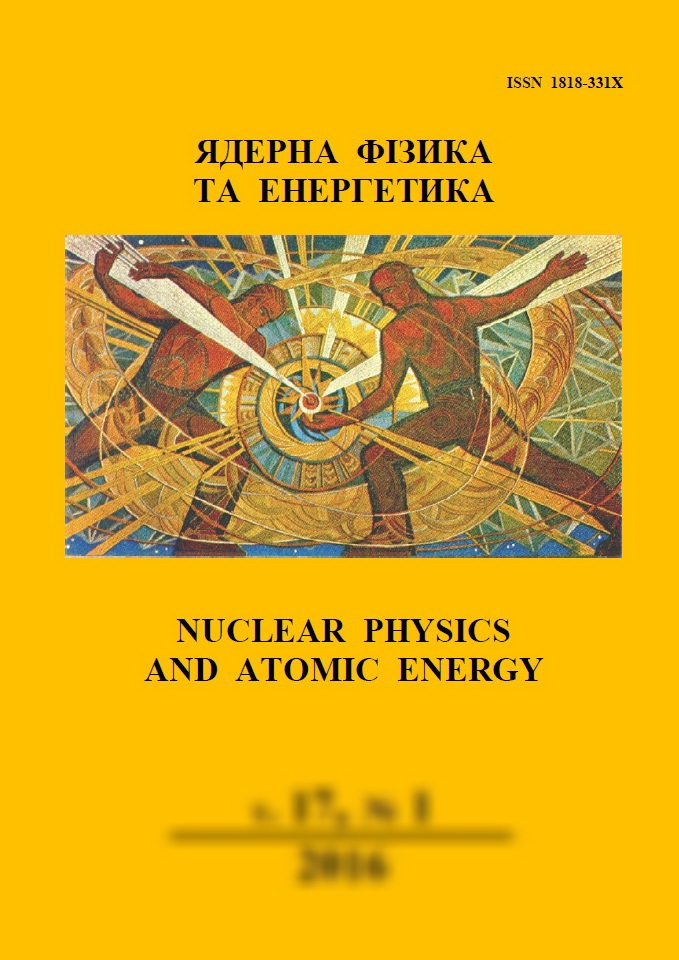 |
▀ńňÝÓ ˘│šŔŕÓ ˛Ó ňÝňŃň˛ŔŕÓ
Nuclear Physics and Atomic Energy
ISSN:
1818-331X (Print), 2074-0565 (Online)
Publisher:
Institute for Nuclear Research of the National Academy of Sciences of Ukraine
Languages:
Ukrainian, English, Russian
Periodicity:
4 times per year
Open access peer reviewed journal
|
Nucl. Phys. At. Energy 2016, volume 17, issue 1, pages 27-37.
Section: Atomic Energy.
Received: 03.02.2016; Accepted: 11.04.2016; Published online: 02.06.2016.
 Full text (ua)
Full text (ua)
https://doi.org/10.15407/jnpae2016.01.027
An analysis of the fuel element cladding failure parameter considering the nonuniformity of energy release in a fuel assembly
S. N. Pelykh1,*, M. V. Maksimov1, S. D. Ryabchikov2
1Odessa National Polytechnic University, Odessa, Ukraine
2Kharkov Institute of Physics and Technology, Kharkov, Ukraine
*Corresponding author. E-mail address:
pelykh@i.ua.
Abstract:
Considering the fuel assembly (FA) load history and the nonuniformity of energy release for the fuel elements (FEs) contained in this FA, a method for forecasting of probability of VVER-1000 FE cladding failure due to FE cladding deformation damage accumulation, has been developed. In the case of four-group damage distribution model, the maximum value of damage parameter accumulated in a four-year fuel campaign is approximately twice greater comparing with the one-group model. A FA rearrangement algorithm characterized by exceeding of the limiting value for cladding damage parameter and the safety margin for VVER-1000 operation, has been found. The thesis that the value of FE cladding damage parameter plays an important role in estimating the limit state of claddings, has been proved. The condition of FA rearrangement algorithm admissibility and the criterion of minimum cladding failure probability which can be used in a control system insuring the hermeticity of VVER-1000 FE claddings, have been derived.
Keywords:
VVER-1000, fuel element cladding, criterion of minimum cladding failure probability.
References:
1. V.V. Popov. Development and improvement of the methods for calculation of the strength and reliability of NPP fuel rods: Thesis abstract. Doctor of Sciences in Technology (Obninsk, 2000) 62 p. (Rus)
2. E.E. Alexeyev. Development of the methods for calculation of the VVER fuel element workability using probabilisti˝ and deterministi˝ approaches: Thesis abstract. Candidate of Sciences in Technology (Obninsk, 2008) 31 p. (Rus)
3. Nuclear fuel safety criteria technical review. Second edition. OECD NEA No. 7072 (Issyles-Moulineaux: Nuclear Energy Agency, 2012) 83 p.
nea7072-fuel-safety-criteria.pdf
4. V.V. Novikov, A.V. Medvedev, S.M. Bogatyr. Nuclear fuel operability assurance in maneuver regimes. Proc. of the Int. Ukrainian-Russian Conf. on Experience of the New VVER Fuel Operation (Khmelnitskiy, Ukraine, 2005) p. 22 (Rus)
5. O.V. Sosnin, B.V. Gorev, A.F. Nikitenko. Energy Variant of the Theory of Creep (Novosibirsk: The Siberian Branch of the USSR Academy of Sciences, 1986) 95 p. (Rus)
6. J.H. Kim, M.H. Lee, B.K. Choi et al. Deformation behavior of Zircaloy-4 cladding under cyclic pressurization. Journal of Nuclear Science and Technology 44 (2007) 1275.
http://doi.org/10.1080%2F18811248.2007.9711371
7. S.N. Pelykh, M.V. Maksimov. Cladding rupture life control methods for a power-cycling WWER-1000 nuclear unit. Nuclear Engineering and Design 241(8) (2011) 2956.
https://doi.org/10.1016/j.nucengdes.2011.05.011
8. S.N. Pelykh, M.V.Maksimov, V.E. Baskakov. Grounds of VVER-1000 fuel cladding life control. Annals of Nuclear Energy 58 (2013) 188.
https://doi.org/10.1016/j.anucene.2013.03.020
9. ╠. Suzuki. ╠ţdelling of light-water reactor fuel element behaviour in different loading regimes. Transl. from English by S. N. Pelykh (╬dessÓ: └stroprint, 2010) 248 p. (Rus)
10. Nuclear safety regulations for NPP reactor plants NP-082-07 (╠oskva: Federal Environmental, Industrial and Nuclear Supervision Service, 2008) 21 p. (Rus)
11. S.N. Pelykh. Grounds of VVER fuel element behavior control (Saarbrucken: Palmarium Academic Publishing, 2013) 160 p. (Rus)
12. N. Pelykh, M.V. Maksimov, G.T. Parks. A method for VVER-1000 fuel rearrangement optimization taking into account both fuel cladding durability and burnup. Nuclear Engineering and Design 257 (2013) 53.
https://doi.org/10.1016/j.nucengdes.2012.12.022
13. V.D. Shmelev, Y.G. Dragunov, V.P. Denisov. The VVER active cores for nuclear stations (╠oskva: └kademkniga, 2004) 220 p. (Rus)
14. S.N. Pelykh, M.V. Maksimov, M.V. Nikolsky. A method for minimization of cladding failure parameter accumulation probability in VVER fuel elements. Problems of Atomic Science and Technology. Ser. Physics of Radiation Effect and Radiation Materials Science 4 (2014) 108.
15. M.V. Maksimov, S.N. Pelykh, V.E. Baskakov, T.A. Tsiselskaya. Patent. 100070, Ukraine, ╠P╩ G 21 C 7/00. A method for control of the VVER nuclear power plant at changing the reactor power or external loading. Bul. No. 21/2012. (Ukr)
16. R.Y. Vorobyev. Albums of neutron-physical characteristics of the reactor core. Unit 5, Zaporizhzhya NPP. Campaigns 20 - 23 (Energodar: Zaporizhzhya NPP, 2011) 323 p. (Rus)
17. P.┼. Philimonov, V.V. MÓmichev, S.P. Averyanova. The ôreactor simulatorö code for modelling of maneuvering WWER-1000 regimes. └tomnaya Energiya 84(6) (1998) 560. (Rus)
18. M. Suzuki. Light water reactor fuel analysis code FEMAXI-V (Ver.1). JAERI-Data/Code 2000-030 (Tokai: Japan Atomic Energy Research Institute, 2000) 285 p.
http://www.iaea.org/inis/collection/NCLCollectionStore/_Public/32/009/32009104.pdf
19. Y.A. Chao, Y.A. Shatilla. Conformal mapping and hexagonal nodal methods - II: Implementation in the ANC H code. Nuclear Science and Engineering 121(2) (1995) 210.
http://dx.doi.org/10.13182/NSE95-A28559
